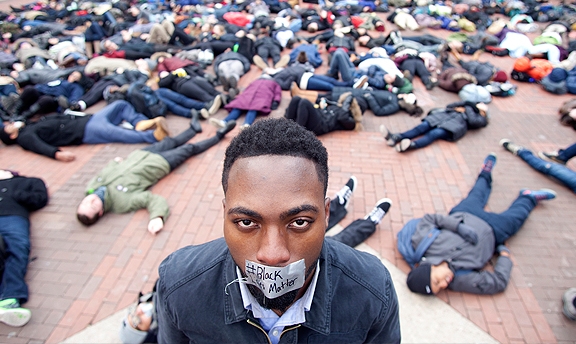A Hashtag for TV Crime Series: #CultureSoWhite

Her screams echo through the dark house. Eerie music plays while the oh-so sadistic murderer chops his victim to pieces with an axe. Blood sprays everywhere. Within minutes the young girl lies dead on the tiled bathroom floor.What did you picture for these two characters? A white male in his early thirties mercilessly brutalizing a youthful twenty-something white woman? That would be the standard image, at least when considering crime series trends.
According to criminology professor Annette Houlihan, serial killers are almost always middle-aged white males. And the murder victims? She says that “these narratives also rely on the on the construct of ideal victimology…and they are almost invariably unsuspecting, Caucasian and female.” In the age of #BlackLivesMatter and #OscarsSoWhite, the role of the victim in popular TV crime show culture seems to remain reserved solely for the young white girl. This typecast upholds the precedent that the one, true victim worthy of universal sympathy is an innocent Caucasian female. Countless serial killer-centric crime series follow this pattern. Dexter, Criminal Minds and Law and Order: SVU all play on this paradigm, as observed by Dr. Houlihan. It's a prevailing theme that people of color are treated with unfair bias, devoid of representation on the small screen.
Yet it is through real-life stories that many of these crime shows create their serial killers and it is most definitely not only white women who are victims in real-life scenarios. The media has an important role to play, as series writers often take inspiration from news headlines. Deborah Schurman-Kauflin took notice of such race issues in Psychology Today: "Since 2005 nine women's bodies turned up near bridges and woods in…a population of around 60,000,” she wrote in 2011, "You would think this would be a case covered on the crime shows. Alas, few have heard much about it.” The reason the media and others never took notice, she argues, is because "the victims have been poor, African American females.”
If women of color are treated with little respect and sympathy in reality, how can it be expected for them to receive better from shallow, judgmental Hollywood? The Academy Awards, for instance, didn’t nominate a single black actor for the Best Actor category this year even when presented with a host of deserving candidates. This prompted a strong call to boycott the Oscars from prominent celebrities. Jada Pinkett Smith tweeted about how black individuals are welcomed to host the Oscars, but "[we are] rarely recognized for our artistic accomplishments.”
Stacey Dash, a black actress known for her role as Dion in the film Clueless, responded to this boycott during an interview on Fox Five: “Either you want to be segregated or integrated. If you want to be integrated then you don’t need things like BET or the BET awards…where you have to be black in order to win these.” In another interview on Fox&Friends she noted that there shouldn’t be Black History Month either.
The common idea argued by Dash points towards an idealistic, unrealistic society where everyone gets their share of the cookie. Unfortunately, black Americans are historically underrepresented throughout media. When it comes to awards shows, black people can’t win—let alone be nominated for—unless if they’re specifically sectioned off. In crime series, they’re only deserving when the writers finally turn pertinent news headlines regarding people of color into an episode.
Law and Order: SVU is one of the three popular crime shows with historic underrepresentation that has pulled such headlines. The recent episode titled ‘Community Policing’ garnered controversy from both sides of the aisle over the representation of the BlackLivesMatter movement. In the episode, an innocent black individual is shot 35 times by two cops searching for a rape suspect in a low-income, primarily black neighborhood. The cops claimed to have seen a gun, but no weapon was found on the suspect. Throughout the length of the episode, the protagonist detectives are on the side of the cops and it is only the District Attorney who is adamant in pressing charges. The cops are indicted by a grand jury on counts of manslaughter and reckless endangerment, but the detectives don’t believe that they’ll be found guilty because all ‘protocol' was followed. The episode ends with a random cop being killed during a routine traffic stop.
The episode deftly straddles the line between supporting and opposing the BlackLivesMatter movement by allowing the viewer to make their own decision based off of their previously held notions. It only serves to reinforce the notions that black victims—true, innocent victims—are not deserving of clear narrative or audience sympathy.
Without proper representation in all media, especially crime series, black individuals can never be seen as worthy of sympathy. These archaic notions keep human society suspended from reality. Even when a crime series depicts a black individual as purely and wholly innocent, there is a spin taken on it to show that not only are cops’ jobs dangerous in general—which is already blatantly obvious—but that the series’ protagonists side with the accused cops as well.
Sympathy is something that is inherent to human nature. When it is stripped from an entire race of people merely for the color of their skin tensions begin to rise. The BlackLivesMatter movement dominates the political landscape of the U.S. and with events like #OscarsSoWhite, it’s only a matter of time until boycotts and protests become an even more serious, more debilitating issue to the fabric of American social culture than it is currently. Once the issue is shoved into the light, progress is inevitable.










